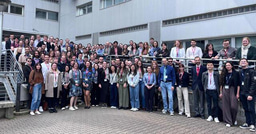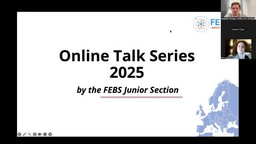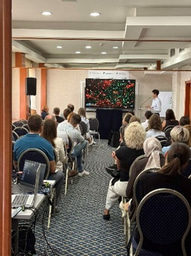Innovative teaching in the molecular life sciences – you can do it too!

When I began my first full time lecturing job in September 2019, little did I know that I would have approximately six months of “normality” before the COVID-19 pandemic changed teaching and learning in Higher Education forever. Luckily, through my work in science communication and public engagement, I had experience of engaging a variety of audiences in different contexts, including online. I quickly realised that I needed to rapidly adapt my teaching approaches for the new online environment that we all found ourselves in.
The speed of change brought about by the pandemic was phenomenal and something that I admit, I struggled with. In addition, in the midst of a pandemic, my role as an educator seemed insignificant in relation to others on the front line and the personal and global challenges which we were all facing. But upon reflection, I realised that I had a unique opportunity during this unprecedented time. I could use my skills to adapt my teaching approaches to help others (both learners and colleagues) through what was an incredibly challenging time for everyone. Through my small contribution to teaching and learning, I could deliver online content and teaching in an interactive, engaging and compassionate way, giving learners something to look forward to that they also found enjoyable. I was in a very privileged position as I could influence the lives of learners through my engaging and innovative teaching, and let’s face it, amid a pandemic, anything that helps to improve daily life was very much welcome.
What is innovative teaching?
My colleagues began to use the word “innovative” to describe the adaptations and modifications that I had made to my online teaching. Although I must confess that I did not think any of the changes that I had made were particularly “innovative”, they just made sense to me based on my experience in communicating science and engaging different audiences.
Innovative teaching is defined as “the process of proactively introducing new teaching strategies and methods into the classroom.” (1). Based on this definition, you could argue that I had been innovative in my teaching approaches, even if I did not recognise it myself! But importantly, for me, innovations in teaching are not just about introducing new teaching methods for the sake of it without rhyme nor reason. There must be some rationale and justification as to why teaching innovations are introduced. In my teaching approaches, I am constantly looking for ways in which I can innovate to make learning opportunities more engaging and equitable for learners. So, before I introduce any teaching change or innovation, I ask myself “what problem am I seeking to solve and why?”.
Here are some examples of teaching innovations that I have made to my bioscience teaching.
Wellbeing polls
As we pivoted to online lectures, I missed welcoming learners into the physical learning environment, and I was unable to “read the room” and consequently modify my teaching style and delivery as I routinely did for in-person lectures. Furthermore, during the pandemic I wanted learners to know that I cared and empathised during this challenging time. In this instance the problem that I was looking to solve was to be able to understand how my learners were feeling while also demonstrating to them that I cared about them. Therefore, to mitigate this, I introduced a simple innovation to my teaching sessions; I began my online teaching sessions with an anonymous and interactive wellbeing poll. I simply asked learners “How are you doing today?” when beginning the session and gave them a variety of multiple-choice responses to vote on:
Question – “How are you doing today?”:
- Doing great
- Feeling ok
- Not feeling great
- Chuffed–Wales won the rugby 😊
- Brrrrrr–it’s cold!
- Show me the answers
The introduction of wellbeing polls provided an opportunity for learners to anonymously check-in with their own wellbeing on that particular day. As an educator I was then able to use my compassionate approach, briefly discussing how I was feeling, alongside commenting on the results, before signposting and reminding students of support services available to them throughat the university, as appropriate. The introduction of wellbeing polls was such a huge hit with learners that I have retained them for in-person lectures:
“I love the wellbeing polls. Emma, you understand and care about us. I appreciate that you ask us how we are…especially useful when I was feeling low…you reminded me people do care.” Year-1 Student
I am still astounded that such a simple innovation can have such a big impact on the learning environment, and I am aware of learners who have sought additional support specifically because I invited them to because of the wellbeing polls.
The power of music
I really enjoy listening to music, particularly while I work, and I was intrigued by evidence that music can be a powerful pedagogical tool to enhance learning (2). In this teaching innovation, the problem that I was looking to solve was to enhance the learning experience and environment for learners, specifically by using music. Consequently, I began to include musical introductions into my teaching, playing music in the awkward silence at the beginning of an online teaching session. I was shocked by the impact that this simple addition had on learners. The learning environment was transformed, many students smiled and danced along, this brought energy and uplift to the teaching session.
Subsequently I expanded the innovation to create an interactive opportunity for learners. I contacted learners prior to the teaching session to ask for their song requests, with the caveat that they must link (albeit tenuously) to the topic. The “mini-discos” that I have created by playing music at the beginning of teaching sessions have been a huge success, receiving phenomenal student feedback. Students now compete against each other to suggest and vote for the “best” songs. The impact of “mini-discos” on learners is clear; students feel welcome, they report enhanced wellbeing and they enjoy learning more:
“Everyone genuinely looks forward to Emma’s lectures, her teaching approach and use of music is so refreshing and helped me stay motivated.” Year-3 Student
You can be an innovative educator too
When colleagues used the word “innovative” to describe my teaching approaches, I did not think that the simple changes that I had introduced were particularly innovative. It took me a while to realise that teaching innovations do not need to be complex or grand. All of us can innovate in our teaching, it does take time and resource, but we can all be innovative educators. The key to being an innovative educator is thinking about the reason you are changing something and the specific problem that you want to solve in a creative way. To be a truly innovative educator, you must be willing to accept and even embrace the fact that things may not always work perfectly, and they may go wrong. The first time you trial something new or innovative in your teaching, it can be scary, but that does not mean you should not try at all. The joy of being an educator is that we are still learning every day. So, let us innovate to educate, after all, our learners deserve it.
References
- https://www.reference.com/world-view/innovative-teaching-278a1b0503ce263
- Dosseville, F., et al 2012. Music during lectures: Will students learn better?. Learning and Individual Differences, 22(2),pp.258-262.
Photo by Trust "Tru" Katsande on Unsplash





Join the FEBS Network today
Joining the FEBS Network’s molecular life sciences community enables you to access special content on the site, present your profile, 'follow' contributors, 'comment' on and 'like' content, post your own content, and set up a tailored email digest for updates.
I am also very dedicated to engage students in my classes. I also use music and dancing and it makes a huge difference. Congrats!